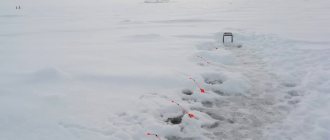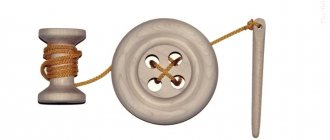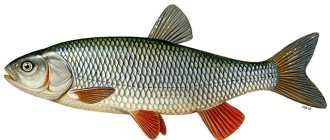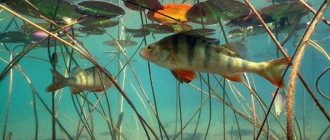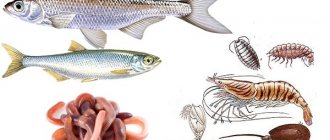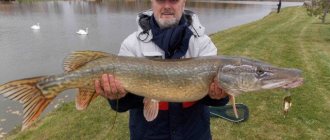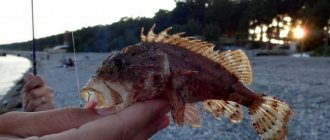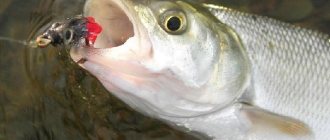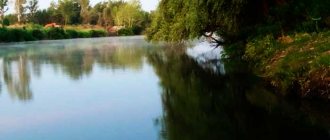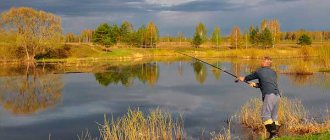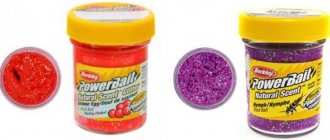Winter smelt fishing attracts a large number of amateur and professional winter fishers. For many, this type of recreation on ice brings a lot of impressions and pleasure, starting from searching for smelt, drilling holes, arranging fishing rods and waiting for the dynamic twitching of nods, running from hole to hole pulling out smelt from the depths one after another. And there doesn’t seem to be anything complicated about winter smelt fishing and, nevertheless, one fisherman can catch 5-20 smelts, and another fisherman will catch 50-100 smelts in the same place and at the same time. This is where the questions begin regarding the correct choice of tackle, fishing rod rigging, choice of jigs for smelt and bait.
Smelt fishing rod and equipment
The choice of fishing rod for smelt is of great importance for many reasons. Since winter smelt fishing requires high activity from the fisherman, you have to fish with several fishing rods at once and at great depths, and sometimes you have to quickly change the place if there is no bite. That is, collect all the gear, quickly move to another place, and reinstall all the fishing rods. Therefore, smelt fishing rods must have the ability to quickly reel in fishing line and the ability to quickly attach hooks. And also the specificity of winter fishing for smelt is that when biting, you need to sharply hook the fishing rod and throw it onto the ice, and then pull the line out with your hands. And the smelt fishing rod must withstand such repeated falls and not break.
Usually, when fishing for smelt, each fisherman has several fishing rods, many even arrange too many fishing rods, 15-20 pieces each. But realistically, it is enough to have 5-10 fishing rods with you for smelt, and it is better to place no more than 8 fishing rods, since it is inconvenient to maintain, change bait and light jigs for smelt with more than 8 fishing rods. And 1-2 fishing rods remain in reserve in case the main fishing rods get tangled, and this happens quite often, and in the cold and wind it is easier to get a reserve fishing rod than to untangle the beard on the fishing line. And be sure to have a trolling rod with you, equipped with a smelt lure. Sometimes smelt are caught very successfully using a spoon.
There is another restriction on the number of fishing rods for catching smelt, which in the fishing rules entails a financial fine. There should be no more than 10 hooks or jigs per fisherman. In winter, the number of hooks in smelt gear placed at the holes can be counted right on the ice by a fishery control and supervision inspector who suddenly appears and issues a fine if the rules are violated. Such situations have already begun to occur in the Gulf of Finland during winter smelt fishing. But so far such inspections are not very frequent.
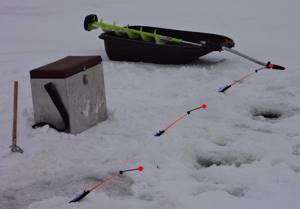
So, based on the above requirements, the smelt fishing rod must be durable and equipped with a reel for fishing line, and the fishing rod must float if it falls into the hole. Based on the experience of catching smelt, the best smelt fishing rod was one made by hand from finely porous and durable foam, which has a yellowish tint. Such foam was usually used for large floats in commercial fishing nets; such floats could be found on the shore of the bay, washed up by a storm.
Oblong bars are cut from polystyrene foam, with dimensions of 15-18 cm in length, 3.5-4.5 cm in width and 2.0-3.0 cm in thickness. You need such bars for fishing rods so that the fishing rod can be conveniently taken even in a mitten. A whip is glued into the block, and a simple and small coil of caprolon is tied to the block with electrical tape. Now such a reel and such foam can be bought on the fishing market, but the price is much higher than for ordinary Chinese fishing rods with a reel.
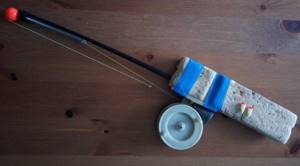
If it’s difficult to make a fishing rod for smelt yourself, then you shouldn’t buy the cheapest one, now there are a lot of poor quality winter fishing rods on sale, and you can still choose a shock-resistant and comfortable fishing rod. If the fishing rod is made of plastic, then it should be frost-resistant, the plastic should not break in the cold, and you should also not take a fishing rod made of white foam, as it is very fragile and breaks instantly with a slight impact or stress. The reel must also withstand falls on ice and frosty weather.
The whip on a smelt fishing rod is also very important and sometimes breaks when hooking, especially in the cold. When choosing a whip for a fishing rod, you will have to experiment, try different ones to find one that is durable and flexible. There are many different whips sold in fishing stores, and you can’t immediately tell by their appearance how high quality they are, so there is one way: take a whip with you fishing and try it on a couple of fishing rods; if the tests are successful, then you can equip all your smelt fishing rods with these with whips. If the whip is too long, then it can be trimmed; a length of 20-25 cm is sufficient, taking into account the fact that a 3-4 cm part of the whip will be inserted into the fishing rod.
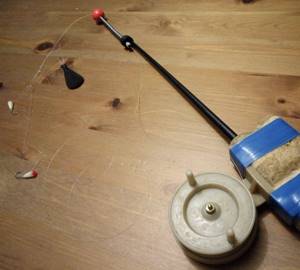
To rig a fishing rod for smelt in winter, you definitely need a nod on the whip. For smelt fishing, it is better to use a spring nod with a red ball at the tip. This nod is not expensive, easy to use and quite durable. The basic requirements for a spring nod, a spring in terms of its elasticity is needed with average indicators; you should not take it too elastic or too flexible. The nod must be able to be adjusted in length, and most importantly, the red ball at the tip of the nod must be small, 1.0-1.5 cm in diameter. A ball that is too large will sway in the wind and create the appearance of a bite.
A spring nod has one drawback: if there is a random knot on the main line, somewhere in the middle, then in cold weather when winding the line, the knot will get stuck in the tip of the nod and then you will have to warm up the tip of the nod a little or pick something there. When it’s cold, ice freezes precisely at the tip of the nod in the ball, for the reason that when there is an active smelt bite, sometimes the fishing rod dives into the water or, when you have to reel in the fishing rod or reel in, the water from the fishing line remains in the tips and freezes there and the knots no longer fit through. Therefore, it is better that there are no knots on the main line, and they are not needed there.
Line and jigs for smelt
In winter gear for smelt, it is better to equip fishing rods with a fishing line of 30 meters, since in winter fishing the depths, for example in many smelt places in the Gulf of Finland, are up to 25-28 meters. And just from a reel of 100 m, there is enough fishing line for three smelt fishing rods. It is better to take a fishing line for smelt with a diameter of 0.25-0.35 mm, and preferably of some bright color so that it can be seen on the white snow. In this gear, the diameter of the main fishing line for smelt is selected larger for the convenience of the fisherman, so that it is easier to drag the fish with his hands by the fishing line and, most importantly, that the fishing line is visible on the snow or ice, and also the thick fishing line will be less likely to get tangled.
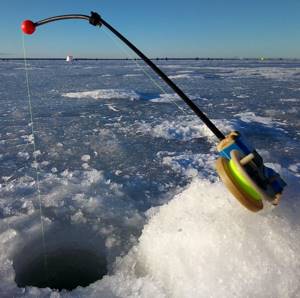
The most important thing in all the equipment for catching smelt in winter is the equipment of the lower part. Many people believe that smelt is so not picky that it will even bite on a rusty nut. But this is not at all true and the bottom part of the equipment is of great importance. To begin with, the tackle for smelt should be less noticeable to the fish, so it is better to tie an insert, a piece of thin or fluorocarbon fishing line 1.0-1.5 meters long and 0.16-0.20 mm in diameter, to the main fishing line below. And already on it, tie a jig for smelt and a sinker at the bottom. In case of breakage or tangling, it is better to have a couple of equipped jig inserts with you on winter smelt fishing; tying a whole equipped insert is easier than tying leashes in the cold.
It is better to choose a sinker for a smelt fishing rod so that it does not roll on the bottom if there is a current or a bottom slope; the best shape for such a sinker is a cone or bell shape with a loop on the top, weighing 25-35 grams. Such a sinker, having been lowered to the bottom, remains in the same position as it was lowered, with the loop towards the top and does not fall on its side. In a current, you may need a heavier sinker, but without a current, you should not equip your fishing rod with too heavy a weight. With a heavy sinker under normal conditions, when biting small smelt, it will not be clear whether there is a fish on the hook after hooking.
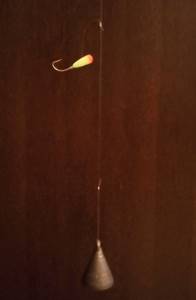
To tie jigs to smelt, it is better to use leashes made of fluorocarbon fishing line of the same diameter as the fishing line from which the insert is made. For a smelt fishing rod, two jigs are enough, one closer to the sinker at a height of 8-15 cm from the sinker, and the second smelt jig should be tied higher, at a distance of 80-120 cm from the sinker. Leashes made from fishing line should be no more than 2-3 cm long, and they need to be tied with a special knot so that the jig sticks out to the side of the main fishing line, and does not hang down with a hook, clinging to the insertion fishing line. In the current, the leashes can be made longer; the current will move the hooks away from the fishing line to the side. Some fishermen tie three jigs to one fishing rod, but this is inconvenient to use.
Typically, smelt bite better on light-accumulating jigs; they contain phosphors; many fishermen call them phosphorus or luminous. What shape and size of jigs to choose for smelt is a difficult question, for the reason that today they bite on some jigs, and on another day the smelt bites on others. Therefore, when fishing, you must have fishing rods with different jigs in shape and size and with different hook sizes. But it is very important that the hooks are sharp, and there will immediately be fewer idle bites. Hooks sometimes become dull, catching on the edge of the hole; for this you always need to have a needle file or a whetstone, a small sharpening stone with you.
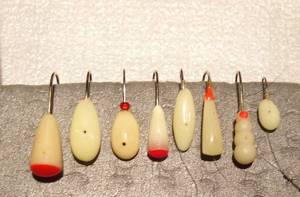
There is an observation that light-accumulating jigs for smelt with a red insert at the top or bottom work better. And so, it’s better if the hole for tying the jig is made through the body of the jig, and not in the form of a loop on top. Having tied a jig without a loop, it hangs perpendicular to the main fishing line, with the hook towards the top. A jig with a loop will hang vertically with the hook down, which is not very good for the smelt bite. And it is also important that the jigs for smelt are new and fresh, since over the years the glow of the phosphor deteriorates, it glows poorly and does not glow much over time, so it is ideal if new jigs are used for the new season.
Tackle for catching smelt
There are three main types of equipment for catching smelt:
- Petty tyrant;
- Mahalki;
- Float.
The tyrant knits on his own. When making tyrants, pieces of thin winter fishing line with a diameter of no more than 0.1 mm of different lengths and hooks are used. It is advisable to make several tyrants at different depths.
Small hooks are needed. At least 5 hooks are strung on each line. A sinker is tied to the end of the fishing line. The tyrant is tied to the line of a simple winter fishing rod. Such tackle is very cheap, although tying a lot of tyrants is a tedious task. But, since you can fish at different depth levels of the reservoir, even a beginner is guaranteed a big catch.
Catching smelt with flies requires some practice. Telescopic fishing rods and small spoons with brass, copper, silver or gold lining are required. Such spinners are quite expensive.
The spoon is tied to a fishing line so that it can move freely (a small loop is made). Colored threads are tied onto the hooks of the spinners. A fisherman in a sitting position can operate both flywheels immediately over a pair of holes.
Let's celebrate! If the bite is very bad, then the preferred option is fishing with a float. This is a very simple tackle. However, it is necessary to use bait: bloodworms, small worms, etc. It is advisable to feed the smelt in advance.
Smelt bait
In winter fishing for smelt it happens very often, so it is not easy to please the fish when choosing bait, even if the gear for smelt is catchy and has been tested on many fishing trips, the fish refuses to bite. Here again the time begins for experiments in choosing smelt bait. Here everyone is good at anything, some fish with shrimp, some with pieces of sausage, and some even catch cut lamprey. You can immediately determine that smelt bites on cut fish from any fish that is found in our reservoirs. I had to catch smelt using perch, roach, crucian carp, ruffe, lamprey, shrimp, maggot, eelpout and myself.
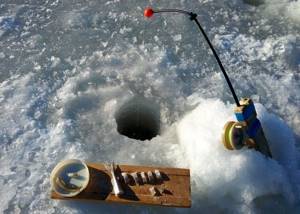
But the most catchy baits for smelt are crucian carp, perch, ruff and smelt itself. Among these baits it is impossible to choose the best one, since on some fishing trips some baits worked better, while on other days they worked worse and vice versa. The main thing is that the smelt bait is fresh. Some fishermen even bring live crucian carp directly to the hole or catch bass closer to the shore in the rocks, and cut them into pieces at the smelt holes. Of course, it is not always possible to find or buy live fish for bait; usually it is purchased chilled crucian carp or frozen smelt caught on a previous fishing trip. But as soon as the first fresh smelt is caught, you should cut it into bait, and you will immediately feel the difference with an increase in the number of bites.
Many fishermen cut bait at home so as not to mess around on the ice; this should not be done, the bait becomes weathered, dries out, loses its juiciness, and becomes unattractive to smelt. Therefore, when winter fishing for smelt, you need to have with you a small board, a sharp knife and a small box for storing the bait fish warm in your bosom. The box is needed in the cold, because it’s easy to cut frozen fish in the cold, but it’s not always possible to put it on a hook, the frozen piece of bait falls apart at the point where it is pierced by the hook, and the hooks become dull when piercing the frozen bait.
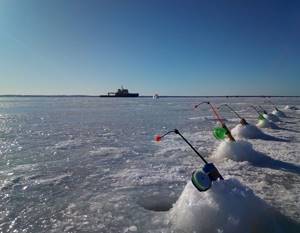
The pieces of fish for bait are not large, you can cut them into squares measuring 5 by 5 mm, or you can cut oblong pieces of 5 mm by 10 mm. The size of the pieces should always be looked at according to the size of the fish that is being caught; if cigarettes are caught, then it is better to cut the bait smaller, but if large mothers are biting, then you can cut it larger. But if you cut crucian carp, perch or roach, then you need to ensure that there are no scales, backbone or ribs in the pieces of smelt bait. And if you cut a smelt or an eelpout, then it is enough to rid the bait of the spine, and the ribs there are almost not noticeable. And it’s always better if the bait has skin, so it will stay on the hook longer, even when the fish has already bitten it. By the way, sometimes smelt bites better on such tattered and shabby pieces than on brand new bait.
Bait
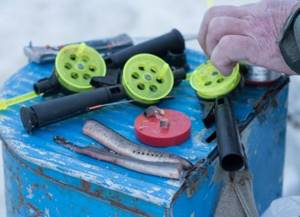
Smelt bites on many things. The bait can be shrimp, seaworm, earthworm, or maggot. In relatively warm weather, say, at 0 °C, earthworms can be dug up directly from under the snow, after having previously pushed it away with a shovel. But the sea sandworm (photo 1) for winter fishing is harvested in the fall; it is caught in puddles on the seashore after low tide. The bottom soil is scooped up with a shovel and dumped in a dry place, sorted, looking for sea worms, and put them in a container. It is not necessary to keep the sandworm alive to catch smelt, so it is stored frozen.
For bait, it is permissible to use loin of navaga, herring, loach (lamprey - photo 2 ) or mackerel. They also use the internal organs of fish as bait. Liver is sometimes used for lamprey, which is ubiquitous in the rivers of the region. Smelt does not hesitate to take baited parts of the body of its relative, eyes or meat. The fillet of the fish is cut into ribbons (photo 3) and placed on a jig (photo 4) - the fishing results are impressive (photo 5) . Fish meat used as bait must be fresh; spoiled meat is ignored and not eaten so readily.
Weather conditions affect the effectiveness of fishing; fishing is possible down to about -15 °C; at temperatures lower, navaga, which is a food competitor of smelt, begins to take hold in the same places. Frosty weather affects the freezing of bait.
It becomes very hard, which prevents the root from swallowing the hook properly and getting hooked. To avoid this, you should change the bait and store a box of natural bait under your clothes near your body.
